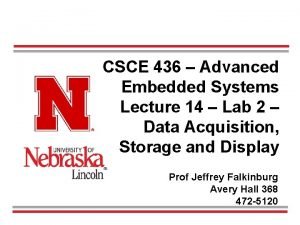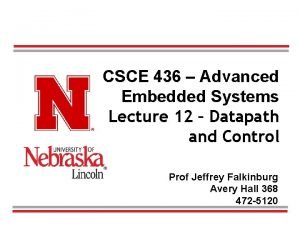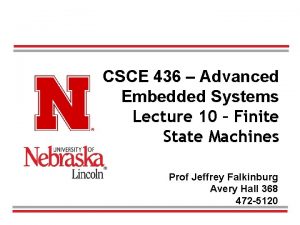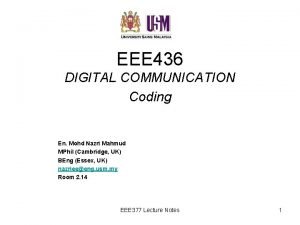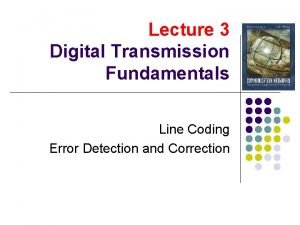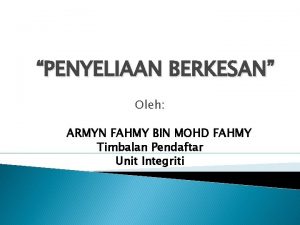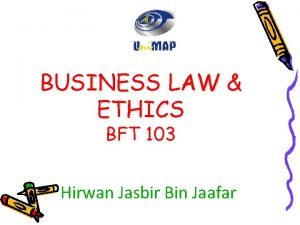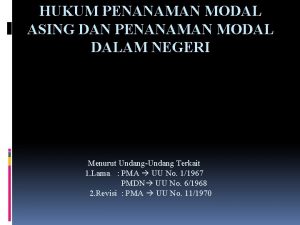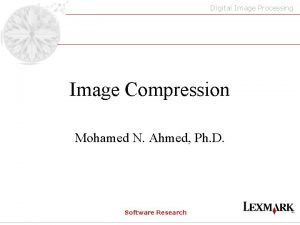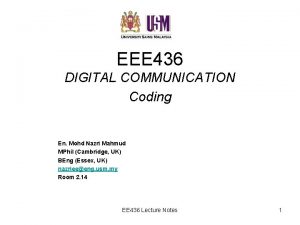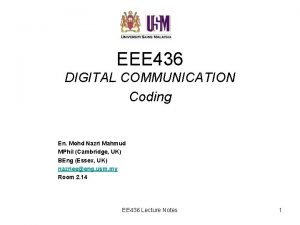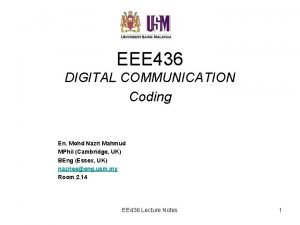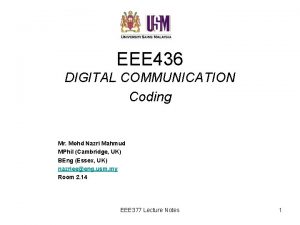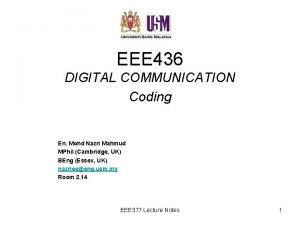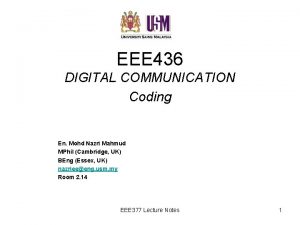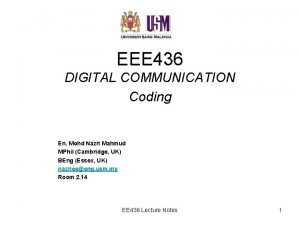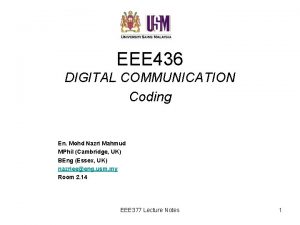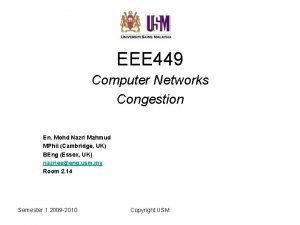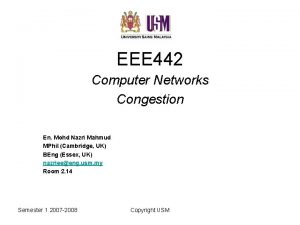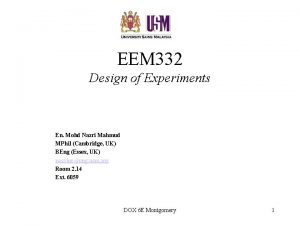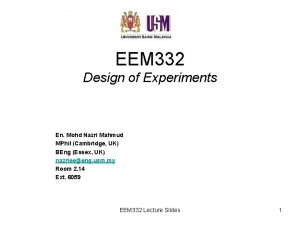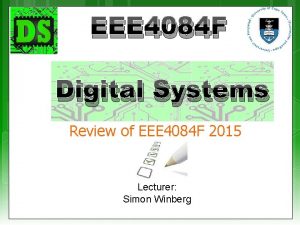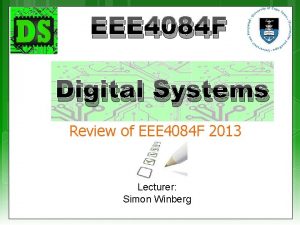EEE 436 DIGITAL COMMUNICATION Coding En Mohd Nazri























- Slides: 23

EEE 436 DIGITAL COMMUNICATION Coding En. Mohd Nazri Mahmud MPhil (Cambridge, UK) BEng (Essex, UK) nazriee@eng. usm. my Room 2. 14 EE 436 Lecture Notes 1

Error Detection and Correction Syndrome Decoding involves parity-check information derived from the code’s coefficient matrix, P. Associated with any systematic linear (n, k) block code is a (n-k)-byn matrix, H called the parity-check matrix. H is defined as H = [In-k PT] Where PT is the transpose of the coefficient matrix, P and is an (n-k)-by-k matrix. In-k is the (n-k)-by-(n-k) identity matrix. For error detection purposes, the parity check matrix, H has the following property EE 436 Lecture Notes c. HT = (0 0 …. . 0) (ie Null matrix) 2

Syndrome Decoding c. HT = (0 0 …. . 0) (ie Null matrix) Since c=m. G, therefore m. G. HT = (0 0 …. 0) This property is satisfied only when c is correctly received. Errors are indicated by the presence of non-zero elements in the matrix. Let r denotes the 1 -by-n received vector that results from sending the code vector c over a noisy channel. When there is an error, the decoding operation will give a syndrome vector, s whose elements contain at least 1 non-zero element. EE 436 Lecture Notes 3

Syndrome Decoding – Example for the (7, 4) Hamming Code A (7, 4) Hamming code with the following parameters n=7; k=4, m=7 -4=3 The k-by-(n-k) (4 -by-3) coefficient matrix, P = P= 1 1 0 0 1 1 1 0 1 The generator matrix, G is, G = G= 1 1 0 0 0 0 1 1 1 0 0 1 0 1 0 0 0 1 EE 436 Lecture Notes 4

Syndrome Decoding –Example for (7, 4) Hamming Code Associated with the (7, 4) Hamming Code is a 3 -by-7 matrix, H called the parity-check matrix. H is defined as H = [In-k PT] 1 0 0 1 0 1 1 1 0 0 0 1 1 1 When a codeword is correctly received, the c. HT will result in a null matrix, otherwise it will result in a syndrome vector, s. EE 436 Lecture Notes 5

Syndrome Decoding –Example for (7, 4) Hamming Code Example: The received code vector is [1110010], check whether this is a correct codeword c. HT = [1110010] 1 0 0 0 1 1 1 0 0 1 EE 436 Lecture Notes 6

Syndrome Decoding –Example for (7, 4) Hamming Code Example: The received code vector is [1100010], check whether this is a correct codeword c. HT = [1100010] 1 0 0 0 1 1 1 0 0 1 = [0 0 1] – this is called the error syndrome EE 436 Lecture Notes 7

Error pattern is an error vector E whose nonzero element mark the position of the transmission errors in the received codeword We can work out all syndromes and find the corresponding error patterns and store them in a look up table for decoding purposes For example the (7, 4) Hamming code EE 436 Lecture Notes 8

Error detection & correction The error pattern, E is essentially the modulo-2 sum of the correct code vector and the erroneous received code vector. For example , c = 1110010 and r=1100010 (ie error in the 3 rd bit) c + r =E 1110010 + 1100010 = 0010000 This error pattern corresponds to a syndrome vector in the look up table, 001 Recall that the syndrome vector, s = r. HT s = (c + E)HT = c. HT + EHT = EHT EE 436 Lecture Notes 9

Error detection and correction Therefore, the decoding procedure involves working out the syndrome for the received code vector and look up for the corresponding error pattern. Then, modulo-2 sum the error pattern, E and the received vector, r , so that c = r + E, and the correct codeword can be recovered. EE 436 Lecture Notes 10

Error detection and correction Example For message word 0010, the correctly encoded codeword is c = 1110010. Due to channel noise, the received code vector is r = [1100010]. Show the decoder recover the correct codeword. 1) The decoder uses r and the HT to find the error syndrome, s S=r. HT = 001 2) Using the resulting syndrome, refer the look up table for the corresponding assumed error vector, E. S=001 corresponds to assumed error vector, E = 0010000 3) Then ex-OR E and r to recover the correct codeword E+r = 0010000 + 1100010 = 1110010 EE 436 Lecture Notes 11

Error detection and correction Exercise i) ii) For message word 0110, the correctly encoded codeword is c = 1000110. Due to channel noise, the received code vector is r = [1100110]. Show the decoder recover the correct codeword. For message word 0110, the correctly encoded codeword is c = 1000110. Due to channel noise, the received code vector is r = [1100100]. Show the decoder performs its decoding operation. What is your observation and explain it. EE 436 Lecture Notes 12

BCH Codes • A class of cyclic codes discovered in 1959 by Hocquenghem and in 1960 by Bose and Ray-Chaudhuri. • Include both binary and multilevel codes • Identified in the form of (n, k) BCH code for example (15, 7) BCH code • A t-error Binary BCH codes consist of binary sequences of length n= 2 m – 1 ; m indicates the corresponding Galois Field • Specified by its generator polynomial, g • The generator polynomial is specified in terms of its roots from the Galois Field, GF(2 m) EE 436 Lecture Notes 13

BCH Codes • To work out the corresponding generator polynomial for example (15, 7) BCH code • First, we need to find m; since n=2 m -1, therefore, for n=15; m = 4 • Then we need to find the primitive polynomial for m=4 from a specified reference table • Then, based on the primitive polynomial, construct the elements of GF(24) • Then find the minimal polynomials of the elements of GF(24) from a specified reference table • Then based on these minimal polynomials , we can work out the generator polynomial. EE 436 Lecture Notes 14

Binary BCH Codes • For our example, (15, 7) BCH code consider a Galois Field with m=4 GF(24) • A polynomial p(X) over GF(24) of degree 4 that is primitive is taken from the following Table of primitive polynomials EE 436 Lecture Notes 15

Binary BCH Codes • • Then, based on the primitive polynomial, 1 + X 4 construct the elements of GF(24) Let alpha (ά) be a primitive element in GF(2 m) Set p(ά)=1+ ά+ ά 4 = 0 , then ά 4 = 1+ ά Using this relation, we can construct GF(24) elements as below EE 436 Lecture Notes 16

Binary BCH Codes Then find the minimal polynomials of the elements of GF(24) from a specified reference table EE 436 Lecture Notes 17

Binary BCH Codes Then the generator polynomial of a t-error correcting BCH code of length 2 m – 1 is given by g(x) = LCM { ǿ 1(X), ǿ 2(X) , …. . , ǿ 2 t (X) } Since every even power of ά in the elements sequence has the same minimal polynomial as some preceding odd power of ά in the elements sequence g(x) = LCM { ǿ 1(X), ǿ 3(X) , …. . , ǿ 2 t-1 (X) } EE 436 Lecture Notes 18

Binary BCH Codes generator polynomial – Example A(15, 7) BCH code (ie n=15) m=2 m-1; m=4 Therefore , refer to Galois Field with m=4 GF(24) A polynomial p(X) over GF(24) of degree 4 that is primitive is taken the table p(X)= 1 + X 4 Then, based on the primitive polynomial, 1 + X 4 construct the elements of GF(24) Then find the minimal polynomials of the elements of GF(24) from the table Then the generator polynomial of a t-error correcting BCH code of length 2 m – 1 is given by g(x) = LCM { ǿ 1(X), ǿ 3(X) , …. . , ǿ 2 t-1 (X) } EE 436 Lecture Notes 19

Binary BCH Codes generator polynomial – Example Then the generator polynomial of a t-error correcting BCH code of length 2 m – 1 is given by g(x) = LCM { ǿ 1(X), ǿ 3(X) , …. . , ǿ 2 t-1 (X) } For 2 -error correcting; t=2 Therefore, g(x) = LCM { ǿ 1(X), ǿ 3(X)} ǿ 1(X) = 1 + X 4 and ǿ 3(X)= 1 + X 2 + X 3 + X 4 g(x) = ǿ 1(X). ǿ 3(X) = 1 + X 4 + X 6 + X 7 + X 8 Exercise : Try out for 3 -error correcting BCH code of the same length EE 436 Lecture Notes 20

Binary BCH Codes generator polynomials – Example EE 436 Lecture Notes 21

Non-Binary or M-ary BCH Codes • Unlike binary these codes are multilevel codes • Operates on multiple bits rather than individual bits • The general (n, k) encoder encodes k m-bit symbols into blocks consisting of n=2 m-1 symbols of total m(2 m-1) bits • Thus the encoding expands a block of k symbols to n symbols by adding n-k redundant symbols • An example of non-binary BCH code is the Reed -Solomon Code EE 436 Lecture Notes 22

RS Codes • A t-error-correcting RS code has the following parameters – – Block length n= 2 m-1 Message size k symbols Parity-check size n-k=2 t symbols Minimum distance = 2 t + 1 • Example RS(7, 4) with m=3 bits EE 436 Lecture Notes 23
 Mohd ridzal bin mohd sheriff
Mohd ridzal bin mohd sheriff Open coding adalah
Open coding adalah Apa itu open coding
Apa itu open coding Csce 436
Csce 436 Csce 436
Csce 436 Csce 436
Csce 436 Physical science 436
Physical science 436 Lempel-ziv coding in digital communication
Lempel-ziv coding in digital communication Nrz format
Nrz format History of qualitative research
History of qualitative research Coding dna and non coding dna
Coding dna and non coding dna Syahid mohd zain
Syahid mohd zain Armyn fahmy mohd fahmy
Armyn fahmy mohd fahmy Mohd talib latif
Mohd talib latif Norizan mohd noor
Norizan mohd noor Kesang leasing sdn bhd v mohd yusof bin ismail
Kesang leasing sdn bhd v mohd yusof bin ismail Merton miller
Merton miller Hiley formula malaysia
Hiley formula malaysia Putra mohd aidil rizal
Putra mohd aidil rizal Ahmad israiwa
Ahmad israiwa Wan mohd faizal
Wan mohd faizal I am a bird by kathrina
I am a bird by kathrina Objective fidelity criteria
Objective fidelity criteria Coding redundancy in digital image processing
Coding redundancy in digital image processing



